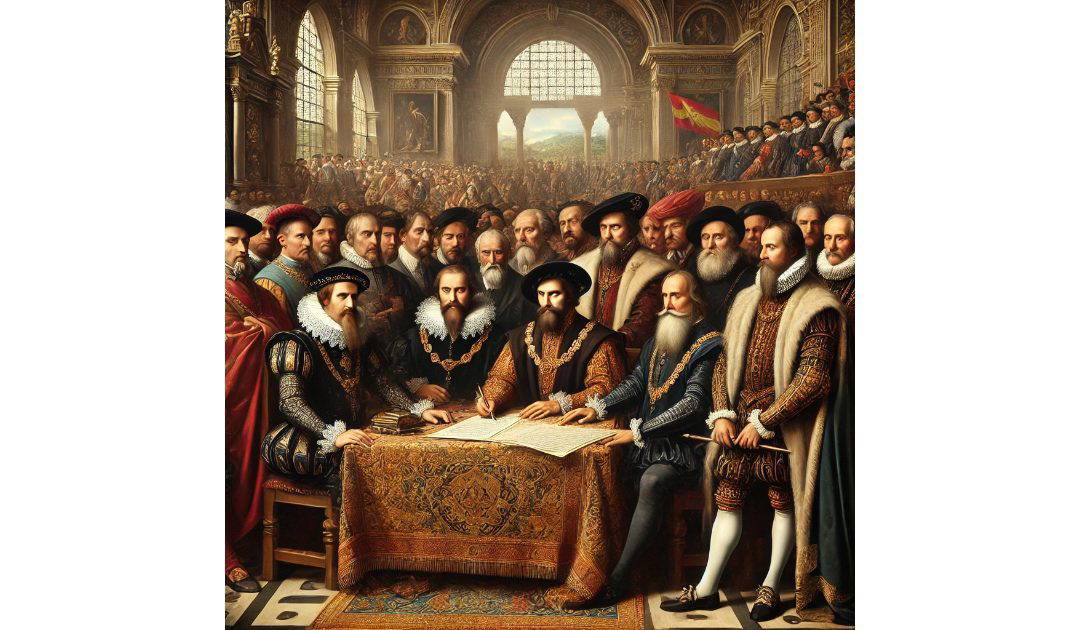On the 22nd of April, 1529, the Treaty of Zaragoza divided the eastern hemisphere between Spain and Portugal. The Treaty of Zaragoza, also known as the Treaty of Saragossa, was a significant historical agreement between the kingdoms of Spain and Portugal. It resolved conflicts over territorial claims in the region of the Moluccas, modern-day Indonesia, following the earlier Treaty of Tordesillas in 1494. This earlier treaty had divided the newly discovered lands outside Europe between the Portuguese Empire and the Spanish Empire along a meridian 370 leagues west of the Cape Verde islands, off the west coast of Africa. However, as explorations continued, ambiguities and conflicts arose, particularly regarding the Spice Islands, which were highly sought after for their valuable spices.
The Treaty of Zaragoza was vital because it demonstrated the growing need for European powers to delineate their overseas empires with precision, as both countries sought to expand their influence globally. The Moluccas were of particular interest due to their role in the lucrative spice trade, which had been a driving force for exploration during this period.
Negotiations leading up to the treaty were complex, involving significant diplomacy and the need to consider both nations’ interests. The conflict over the Moluccas had escalated to such a point that both countries had to address their spheres of influence to avoid military confrontation. Ferdinand Magellan‘s expedition, which was initially a Spanish venture, played a crucial role in highlighting the need for such a treaty, as it had reached the Philippines, challenging Portuguese claims to the region.
The terms of the Treaty of Zaragoza were meticulous in defining the line of demarcation between the Spanish and Portuguese territories. The agreement stated that the line would be drawn 297.5 leagues east of the Maluku Islands. In return for Spain relinquishing its claims to the Moluccas, Portugal agreed to pay Spain 350,000 ducats, a substantial sum at the time. This effectively shifted the line established by the Treaty of Tordesillas further eastwards.
The Treaty of Zaragoza was pivotal in the context of European colonial expansion and international relations in the 16th century. It underscored the importance of diplomacy and negotiation in resolving territorial disputes and demonstrated how economic interests, particularly the spice trade, were often central to such agreements. The treaty also highlighted the limitations of earlier agreements, as the initial division of the world by the Treaty of Tordesillas had not accounted for the Earth’s size, leading to overlapping claims.
Moreover, the Treaty of Zaragoza had long-term implications. It allowed Portugal to consolidate its dominance over the spice trade by securing its claim to the Spice Islands, which were crucial for its economic prosperity. For Spain, although it relinquished its claims in Southeast Asia, it turned its focus more towards the Americas, reinforcing its presence and influence there.
The negotiation process also illustrated the evolving understanding of geography and navigation during the Age of Exploration. It was a period marked by significant advancements in these fields, as European powers were becoming more adept at charting unknown territories. The need for precise demarcation lines was a reflection of this growing knowledge and the economic motivations driving exploration.
Ultimately, the Treaty of Zaragoza was more than just a resolution of a territorial dispute. It was indicative of the broader geopolitical dynamics of the time and the strategies employed by European powers to assert their dominance on the global stage. It marked a critical point in the era of early modern colonisation, setting a precedent for future treaties and territorial negotiations.
In conclusion, the Treaty of Zaragoza is a vital chapter in the history of exploration and colonialism. It reminds us of the historical context of European expansion and the intricate diplomacy required to maintain peace and order as nations vied for global supremacy. Its legacy is seen in the shaping of colonial empires and the economic landscapes of the early modern period, reflecting the profound impact of exploration and commerce on world history.

